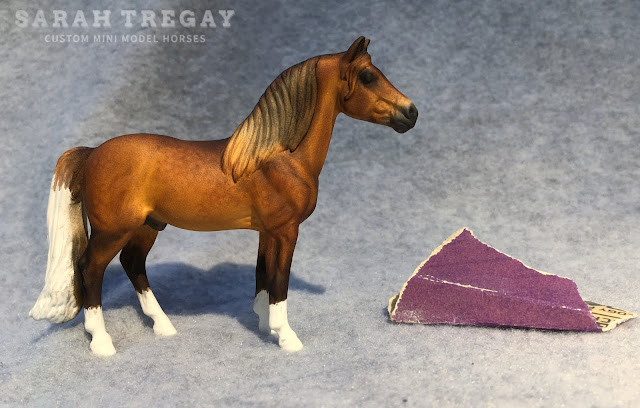I thought I'd share a bit of my process. I'm working in Pan Pastels. The model in question is a simple custom Morgan Stallion from the new standing Stablemate Warmblood mold. He has had some work done on his barrel and hindquarters. His mane and tail have been changed as well.
I prepped him with Rustoleum 2X primer in white and taped off some white markings with blue painters tape.
Feel free to follow along and paint your own golden bay or liver chestnut.
 |
| A Pan Pastel Project |
Art Supplies Shopping list:
- A model with sanded seams and logo removed
- 400 Grit Sandpaper
- Masking or painters tape (optional)
- Rustolem 2X Primer
- Pan Pastels: 280.3 Orange Shade, 820.2 Neutral Grey Extra Dark (or other neutral grey), Layer 3: 740.3 Burnt Sienna Shade, 740.1 Burnt Sienna Extra Dark, 800.5 Black.
- Pan Pastel optional colors for shading mane, tail, and white markings:
- Optional fleshy pink pastel or paint for a pink nose or shading white markings.
- Krylon Matte, Testor's Dullcote, or other matte/dull sealer
- Quality acrylic paint for painting mane, tail, hooves and eyes. Colors may vary.
- A variety of small paintbrushes. Flat angled ones work well for pastel.
- White Microbrush applicators
- Colored pencil or Sharpie to sign your work.
 |
| My Morgan stallion custom and a reference photo. |
 |
| Layer 1: 280.3 Orange shade applied everywhere but nose and sheath |
The most frightening color is 280.3 Orange shade! It goes on fast and bright and doesn't look good. Don't worry. The color is that glowy gold in the golden bay and it tones down when sprayed. For this project I am using Krylon Matte. I also like Testor's Dullcote.
 |
| Layer 2: 820.2 Neutral Grey Extra Dark on nose, eyes and sheath + a second layer of 280.3 Orange Shade over topline, hips and lower legs. |
I have sprayed the model and let him dry between each layer. Here I'm adding another layer of Orange Shade to everywhere that will be gong darker (and leaving the belly light.) Grey skin areas pastelled Neutral Grey Extra Dark. Any of the Pan Pastel Neutral Greys will work for this.
 |
| Layer 3: 740.3 Burnt Sienna Shade added to dark areas (not belly, behind elbows nor nose) |
The next color I used was 740.3 Burnt Sienna Shade. It isn't quite as red as my reference, but will make a nice bay. This color was applied with a large brush, but I targeted dark areas and avoided places I wanted to stay gold.
 |
| Layer 4: 740.1 Burnt Sienna Extra Dark to saddle area, muscle grooves and knees. |
Here with Burnt Sienna Extra Dark I switched to a small brush and focused on the areas that will be dark or black.
 |
| Dapples added with a Microbrush and 740.3 Burnt Sienna Shade, another layer of Grey |
Because I wanted subtle dapples like my reference, I went back to 740.3 Burnt Sienna Shade for the dapples. They are small circles drawn on with a Microbrush. (These look like little Q-Tips and are in the model-car painting section of craft stores. I used the white/small.)
If you wanted to paint a liver chestnut, this would be the place to stop pastelling. After this you'd finish with either a blonde or liver mane and tail.
 |
| Black points added with 800.5 Black to complete the bay. More 740.1 Burnt Sienna Extra Dark applied to darken a few spots. |
It doesn't take much black to turn a liver chestnut into a golden bay. Using a small brush, I added black to the legs, nose, fronts of the ears, and along the roots of the mane and tail. I added a little more 740.1 Burnt Sienna Extra Dark to the face and a few places.
 |
| Painter's tape removed and edges sanded with 400 grit sandpaper. |
 |
| Mane, tail and white markings blocked in with black paint and Gesso. |
At this step I painted the mane, tail and socks. I can add shading to the flat colors with pastels or acrylics.

Comments
Post a Comment